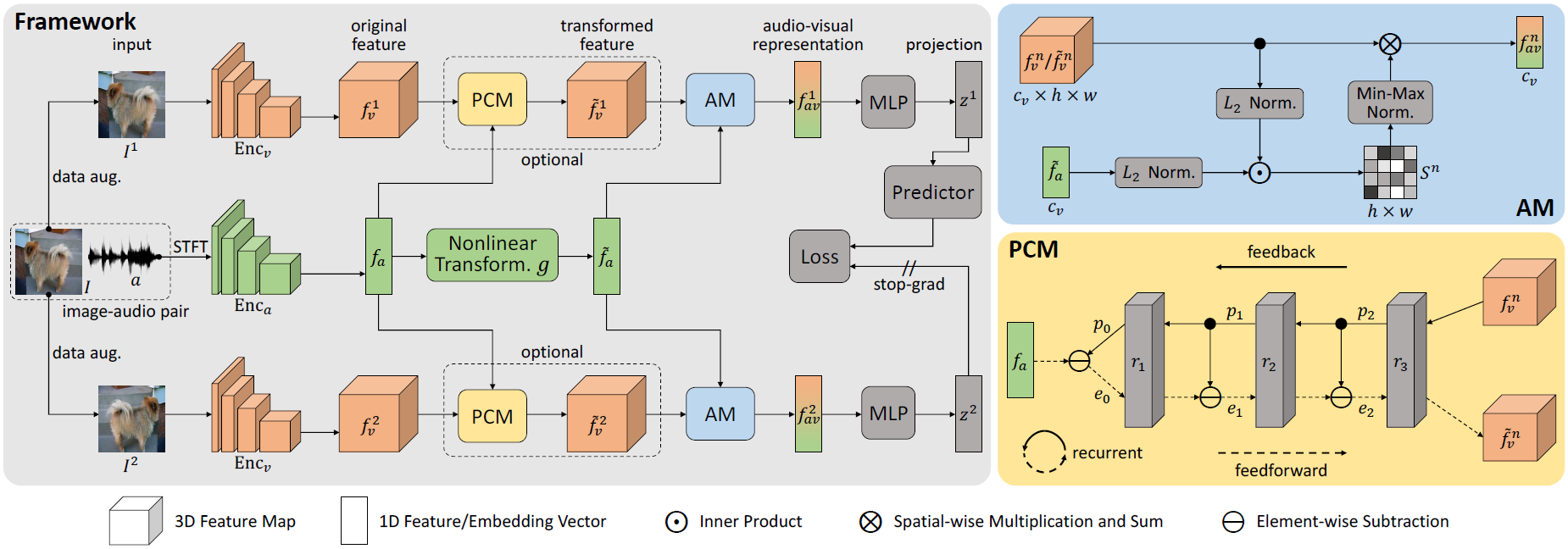This repository hosts the PyTorch code for our self-supervised sound source localization method.
Self-Supervised Predictive Learning: A Negative-Free Method for Sound Source Localization in Visual Scenes
Zengjie Song,
Yuxi Wang,
Junsong Fan,
Tieniu Tan,
Zhaoxiang Zhang
In Proc. IEEE Conf. Computer Vision and Pattern Recognition (CVPR), 2022
[Paper] [arXiv]
Abstract: Sound source localization in visual scenes aims to localize objects emitting the sound in a given image. Recent works showing impressive localization performance typically rely on the contrastive learning framework. However, the random sampling of negatives, as commonly adopted in these methods, can result in misalignment between audio and visual features and thus inducing ambiguity in localization. In this paper, instead of following previous literature, we propose Self-Supervised Predictive Learning (SSPL), a negative-free method for sound localization via explicit positive mining. Specifically, we first devise a three-stream network to elegantly associate sound source with two augmented views of one corresponding video frame, leading to semantically coherent similarities between audio and visual features. Second, we introduce a novel predictive coding module for audio-visual feature alignment. Such a module assists SSPL to focus on target objects in a progressive manner and effectively lowers the positive-pair learning difficulty. Experiments show surprising results that SSPL outperforms the state-of-the-art approach on two standard sound localization benchmarks. In particular, SSPL achieves significant improvements of 8.6% cIoU and 3.4% AUC on SoundNet-Flickr compared to the previous best.
We have tested the code on the following environment:
- Python 3.8.6 | PyTorch 1.6.0 | torchvision 0.7.0 | CUDA 10.1 | Ubuntu 16.04.7
We train models on respectively two video datasets: SoundNet-Flickr and VGG-Sound, while testing on two corresponding benchmarks: test set of SoundNet-Flickr and test set (i.e., VGG-Sound Source) of VGG-Sound. Videos are downloaded with youtube-dl if only the YouTube IDs are given. Please see main text (Sec. 4.2) for details of pre-processing video frames and audio signals. To improve data loading efficiency, we use h5py to respectively group frames, audios, and spectrograms, before training.
Take SoundNet-Flickr for example, the final data should be placed in the following structure:
Datasets
│
└───SoundNet_Flickr
│ │
| └───10k_unlabeled
| | | h5py_train_frames_10k.h5
| | | h5py_train_audios_10k.h5
| | | h5py_train_spects_10k.h5
| | |
| └───144k_unlabeled
| | | h5py_train_frames_144k_1.h5
| | | ...
| | | h5py_train_frames_144k_10.h5
| | | h5py_train_audios_144k_1.h5
| | | ...
| | | h5py_train_audios_144k_10.h5
| | | h5py_train_spects_144k_1.h5
| | | ...
| | | h5py_train_spects_144k_10.h5
| | |
| └───5k_labeled
| | |
| | └───Annotations
| | | | 10000130166.xml
| | | | ...
| | | | 9992947874.xml
| | | |
| | └───Data
| | |
| | └───audio
| | | | 10000130166.wav
| | | | ...
| | | | 9992947874.wav
| | | |
| | └───frames
| | | 10000130166.jpg
| | | ...
| | | 9992947874.jpg
| | |
| └───flickr_test249_in5k.csv
|
└───VGG-Sound
│
└───10k_unlabeled
|
└───144k_unlabeled
|
└───5k_labeled
| |
| └───Annotations
| | | vggss_test_5158.json
| | |
| └───Data
| | h5py_test_frames.h5
| | h5py_test_audios.h5
| | h5py_test_spects.h5
| |
└───vggss_test_4692.csv
Note:
- We provide
flickr_test249_in5k.csv,vggss_test_4692.csv, andvggss_test_5158.jsoninmetadata/. - Before training and testing, you should specify
data_path = "path to Datasets"inarguments_train.pyandarguments_test.pyaccordingly.
We utilize VGG16 and VGGish as backbones
to extract visual and audio features, respectively. Before training, you need to place pre-trained VGGish weights,
i.e., vggish-10086976.pth,
in models/torchvggish/torchvggish/vggish_pretrained/. To train SSPL on SoundNet-Flickr10k with default setting, simply run:
python main.py
Note: We found that learning rates have vital influence on SSPL's performance. So we suggest that using the early stopping strategy to select hyper-parameters and avoid overfitting.
After training, frame_best.pth, sound_best.pth, ssl_head_best.pth (and pcm_best.pth for SSPL (w/ PCM))
can be obtained, and you need to place them in models/pretrain/ before testing. To test SSPL on SoundNet-Flickr
with default setting, simply run:
python test.py
Please consider citing our paper in your publications if the project helps your research.
@inproceedings{song2022sspl,
title={Self-Supervised Predictive Learning: A Negative-Free Method for Sound Source Localization in Visual Scenes},
author={Song, Zengjie and Wang, Yuxi and Fan, Junsong and Tan, Tieniu and Zhang, Zhaoxiang},
booktitle={Proc. IEEE Conf. Computer Vision and Pattern Recognition (CVPR)},
pages={3222--3231},
year={2022}
}
Our code is partially based on Attention, HardWay, and SimSiam. We thank the authors for sharing their code.
